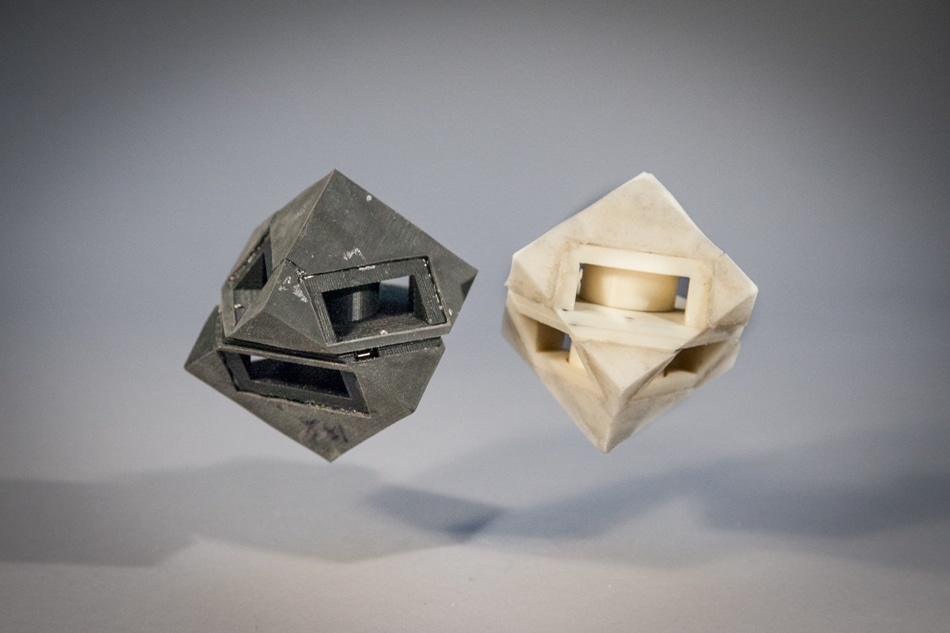Oct 4 2016
 MIT researchers outfitted their cube robot with shock-absorbing “skins” (left) that transfer less than half of the energy that would normally be transferred to the ground. (Photo: Jason Dorfman/MIT CSAIL)
MIT researchers outfitted their cube robot with shock-absorbing “skins” (left) that transfer less than half of the energy that would normally be transferred to the ground. (Photo: Jason Dorfman/MIT CSAIL)
Robots can break, and it is often because they don't have enough padding to protect themselves. Researchers at MIT’s Computer Science and Artificial Intelligence Laboratory (CSAIL) will present a new method for 3D printing soft materials, which would make robots safer and more precise in their movements.
This new method will also enhance the durability of helmets, shoes, phones, drones, and more.
The “programmable viscoelastic material” (PVM) method developed by the team will enable users to program each part of a 3D-printed object to the accurate levels of elasticity and stiffness they want, based on the task required for it.
For example, the team outfitted a robot that moves by bouncing with shock-absorbing “skins” that use only 1/250 the amount of energy it transfers to the ground.
That reduction makes all the difference for preventing a rotor from breaking off of a drone or a sensor from cracking when it hits the floor. These materials allow us to 3-D print robots with visco-elastic properties that can be inputted by the user at print-time as part of the fabrication process.
Daniela Rus, Director, CSAIL
The robot lands almost four times more precisely with the skins, highlighting that the use of similar shock absorbers could help to extend the life time of delivery drones, like those being developed by Google and Amazon.
This research will be presented at IEEE/RSJ International Conference on Intelligent Robots and Systems in Korea. It was written by Rus in addition to three postdocs: lead authors Robert MacCurdy and Jeffrey Lipton, as well as third author Shuguang Li.
Putting a Damper on Things
There are many reasons for dampers, from monitoring the notes of a piano, protecting structures such as towers from storms, and keeping car tires on the ground.
Viscoelastics are the most common damper materials like plastic and rubber that comprise of both liquid and solid qualities. Viscoelastics are easy to find, compact, and cost-effective, but are often only available commercially in particular sizes and also at specific damping levels because customizing them takes up a lot of time.
The team suggested that 3D printing was the only solution. 3D printing has the potential to deposit materials with varied mechanical characteristics into a design, allowing users to “program” material based on their exact requirements for each and every part of an object.
It’s hard to customize soft objects using existing fabrication methods, since you need to do injection moulding or some other industrial process. 3-D printing opens up more possibilities and lets us ask the question, ‘can we make things we couldn’t make before?
Jeffrey Lipton, Postdoc, MIT
With the help of a conventional 3D printer, the researchers used a liquid, a solid, and TangoBlack+, which is a flexible rubber-like material, to print both the cube and its skins. The PVM process is linked to Rus’ earlier 3D printed robotics work, with an inkjet depositing droplets of varied materials layer-by-layer and then solidifying the non-liquids using UV light.
The cube robot comprises inertial measurement unit sensors, a battery, a microcontroller, two motors, and rigid body. Four looped metal strip layers are used as the springs that push the cube.
By combining multiple materials to achieve properties that are outside the range of the base material, this work pushes the envelope of what’s possible to print. Fabricated: The New World of 3-D Printing. On top of that, being able to do this in a single print-job raises the bar for additive manufacturing.
Hod Lipson, Professor of Engineering, Columbia University
According to Rus, PVMs are capable of comprising several other protective uses, including shock-absorbing running shoes and headgear. For example, by damping the motion performed by the motors of the robot, PVMs can protect sensitive parts like sensors and cameras and can also facilitate effortless controlling of the robots.
“Being able to program different regions of an object has important implications for things like helmets,” says MacCurdy. “You could have certain parts made of materials that are comfortable for your head to rest on, and other shock-absorbing materials for the sections that are most likely to be impacted in a collision.”
This research received a grant from the National Science Foundation.
Programmable Viscoelastic Materials
Shock-absorbing skins allow these robots from MIT's Computer Science and Artificial Intelligence Laboratory to land more precisely. One potential application: Extending the lifespan of delivery drones like those being developed by Amazon and Google. (Video: MIT CSAIL)